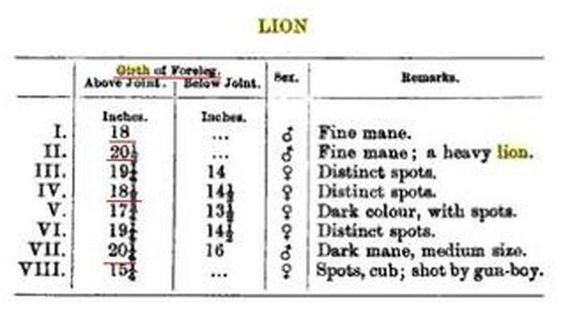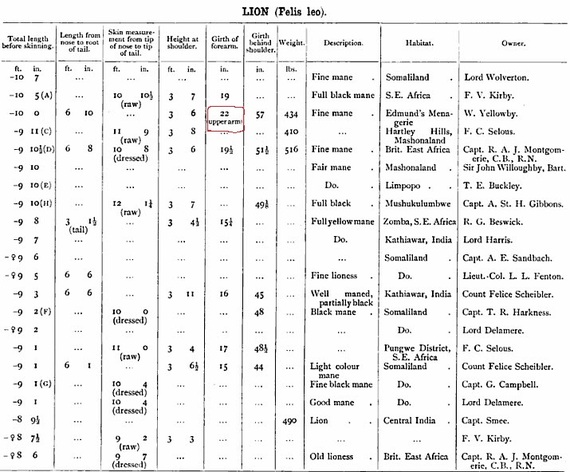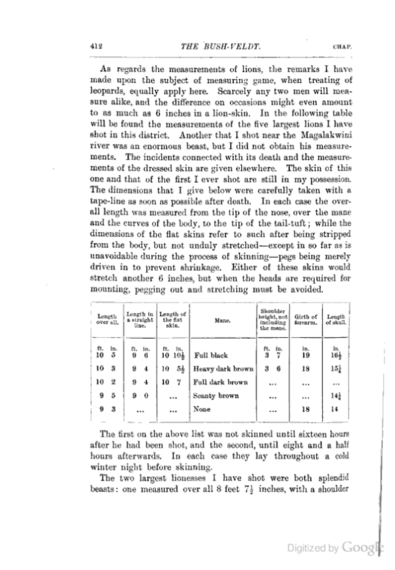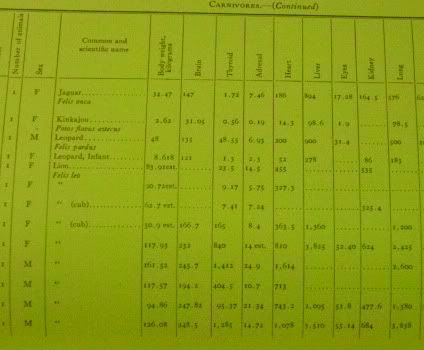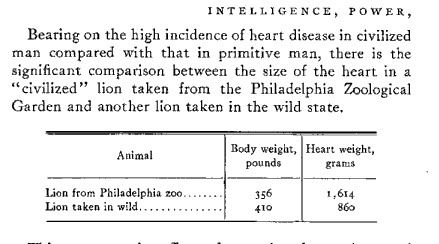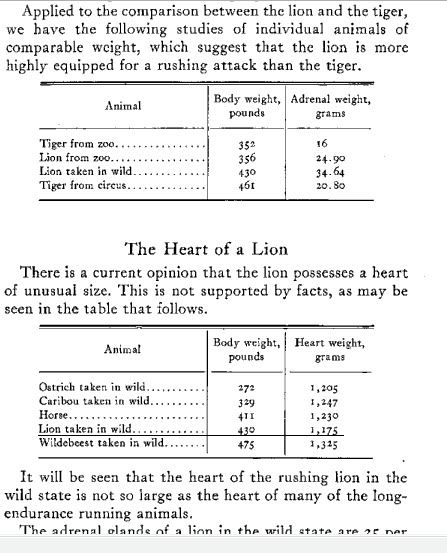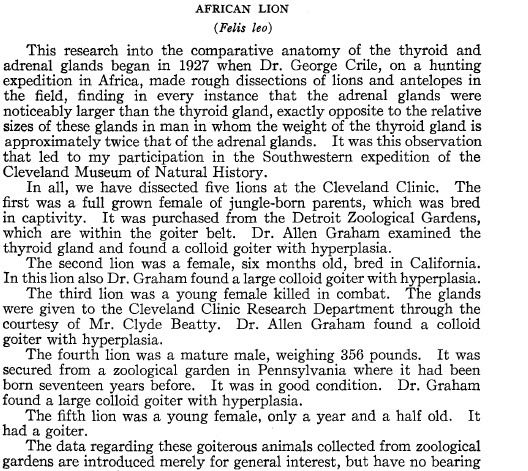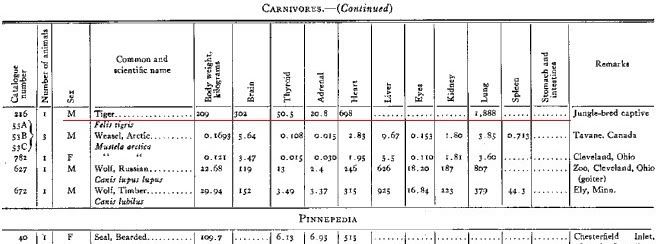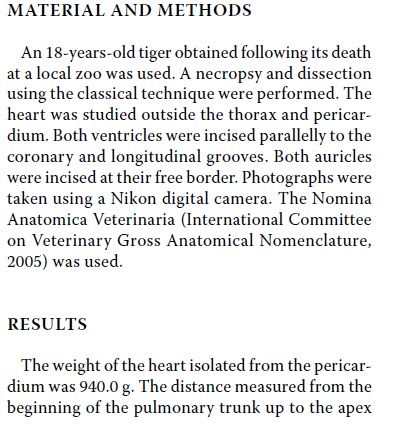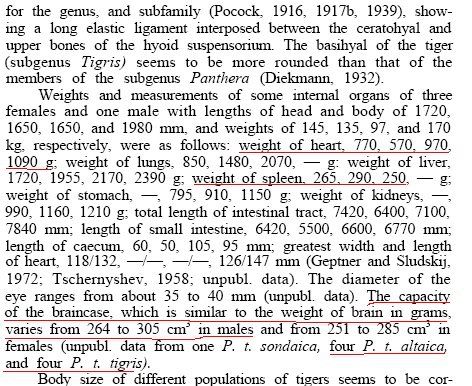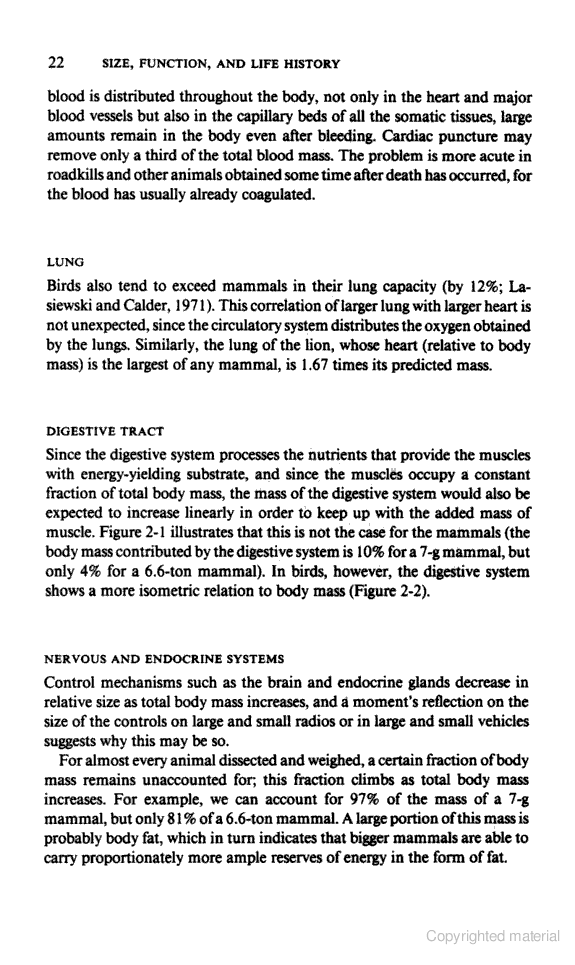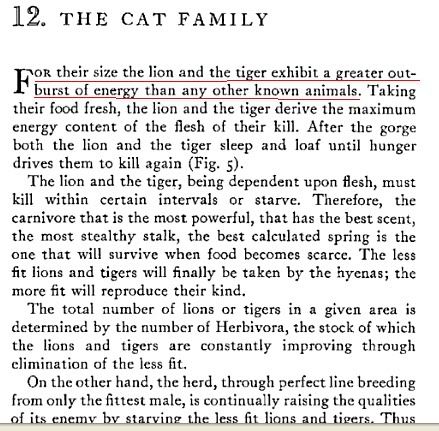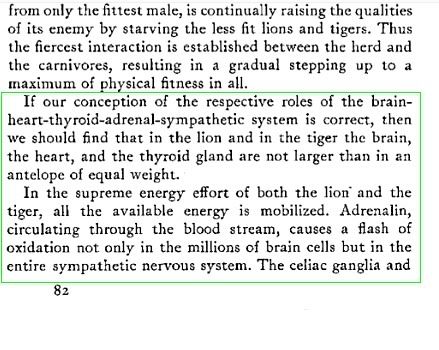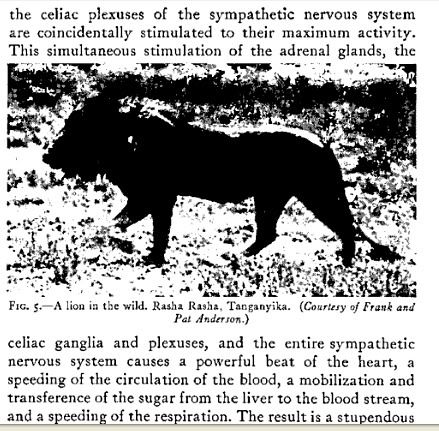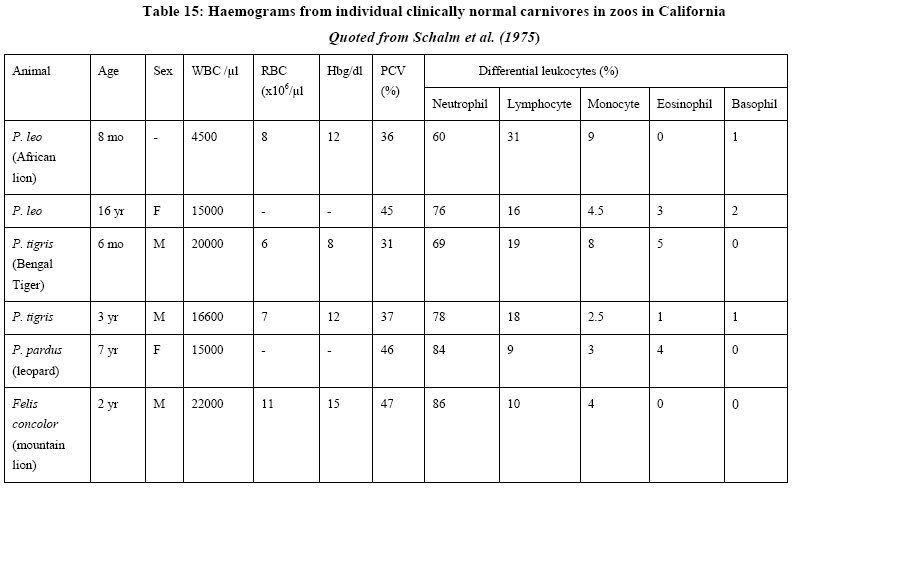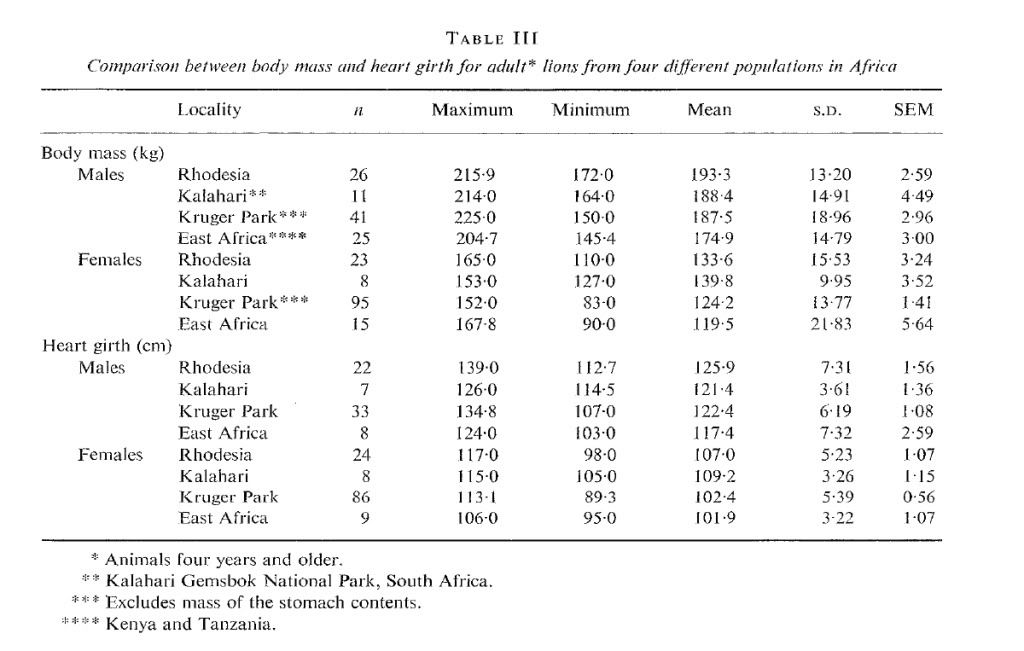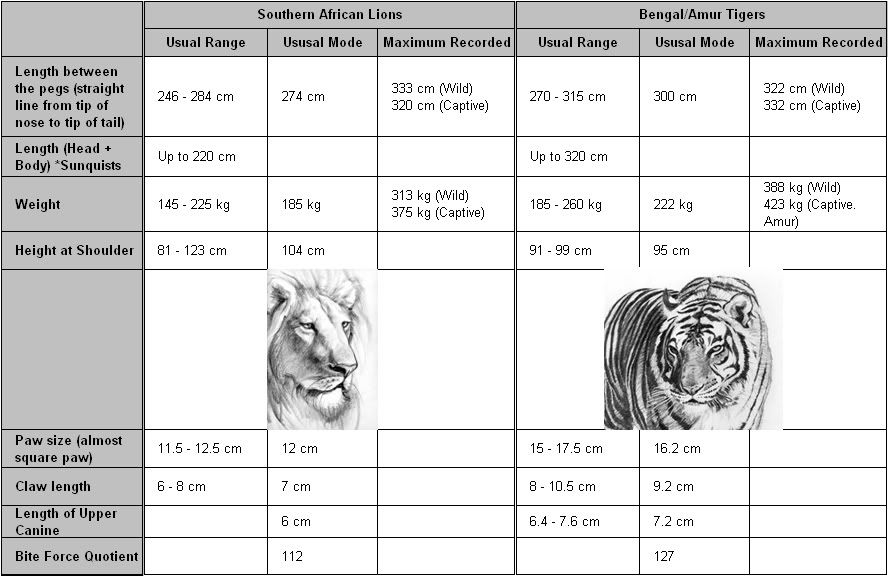Morphology Comparison — Lion vs Tiger
Jun 3, 2013 1:08:22 GMT 5
Grey, creature386, and 1 more like this
Post by Vodmeister on Jun 3, 2013 1:08:22 GMT 5
Pathera Leo vs Pathera Tigris
Credit to founder of initial study goes to Leofwin.
The following is a compilation of the best available data on the forelimb morphologies of the two animals. Data is the standard by which any claim ought to be judged, as it is with the following and the relative strengths of the lion and the tiger.
I. SCAPULAR SIZE:
Study: Christiansen and Adolfssen, 2007.
Metric: Scapular length.
Correlated With: Space for muscle attachment in the shoulders.
Sample Size: 17 lions, 15 tigers.
Lion: 210.2-288.4 mm.
Tiger: 199.1-241.3 mm.
Edge: Lion.
II. HUMERAL ROBUSTICITY BASED ON CIRCUMFERENCE:
Study: Christiansen and Adolfssen, 2007.
Metric: Least circumference of humeral diaphysis in relation to humeral length.
Correlated With: Overall resistance of humerus to stress.
Sample Size: 17 lions, 15 tigers.
Lion: 0.318.
Tiger: 0.303.
Edge: Lion.
Study: Christiansen and Harris, 2005.
Metric: Least circumference of humeral diaphysis in relation to humeral length.
Correlated With: Overall bending strength of humerus.
Sample Size: 3 lions, 5 tigers.
Lion: 0.314.
Tiger: 0.300.
Edge: Lion.
III. HUMERAL ROBUSTICITY BASED ON ML DIAMETER:
Study: Christiansen and Harris, 2005.
Metric: ML diameter of humerus at midshaft in relation to humeral length.
Correlated With: Resistance of humerus to stresses along the ML axis.
Sample Size: 3 lions, 5 tigers.
Lion: 0.0897.
Tiger: 0.0870.
Edge: Lion.
Study: Bertram and Biewner, 1990.
Metric: ML diameter of humerus at midshaft in relation to humeral length.
Correlated With: Resistance of humerus to stresses along the ML axis.
Sample Size: 4 lions, 2 tigers.
Lion: 0.0892.
Tiger: 0.0857.
Edge: Lion.
Study: Meachen-Samuels and Van Valkenburgh, 2010.
Metric: ML diameter of humerus at midshaft in relation to humeral length.
Correlated With: Resistance of humerus to stresses along the ML axis.
Sample Size: 2 lions, 2 tigers.
Lion: 0.0824.
Tiger: 0.0909.
Edge: Tiger.
IV. HUMERAL ROBUSTICITY BASED ON AP DIAMETER:
Study: Christiansen and Harris, 2005.
Metric: AP diameter of humerus at midshaft in relation to humeral length.
Correlated With: Resistance of humerus to stresses along the AP axis.
Sample Size: 3 lions, 5 tigers.
Lion: 0.1098.
Tiger: 0.1037.
Edge: Lion.
Study: Bertram and Biewner, 1990.
Metric: AP diameter of humerus at midshaft in relation to humeral length.
Correlated With: Resistance of humerus to stresses along the AP axis.
Sample Size: 4 lions, 2 tigers.
Lion: 0.1278.
Tiger: 0.1137.
Edge: Lion.
Study: Meachen-Samuels and Van Valkenburgh, 2010.
Metric: AP diameter of humerus at midshaft in relation to humeral length.
Correlated With: Resistance of humerus to stresses along the AP axis.
Sample Size: 2 lions, 2 tigers.
Lion: 0.1144.
Tiger: 0.1096.
Edge: Lion.
V. ML CORTICAL THICKNESS:
Study: Meachen-Samuels and Van Valkenburgh, 2010.
Metric: ML k-value.
Correlated With: Resistance of humerus to stresses along the ML axis (inverse correlation).
Sample Size: 2 lions, 2 tigers.
Lion: 0.489.
Tiger: 0.561.
Edge: Lion.
VI. AP CORTICAL THICKNESS:
Study: Meachen-Samuels and Van Valkenburgh, 2010.
Metric: AP k-value.
Correlated With: Resistance of humerus to stresses along the AP axis (inverse correlation).
Sample Size: 2 lions, 2 tigers.
Lion: 0.571.
Tiger: 0.610.
Edge: Lion.
VII. DISTAL BENDING STRENGTH OF HUMERUS:
Study: Christiansen and Harris, 2005.
Metric: Distal articular width of humerus in relation to humeral length.
Correlated With: Resistance of humerus to stresses at the elbow joint.
Sample Size: 3 lions, 5 tigers.
Lion: 0.1923.
Tiger: 0.1827.
Edge: Lion.
VIII. ROBUSTICITY OF RADIUS BASED ON ML DIAMETER:
Study: Bertram and Biewner, 1990.
Metric: ML diameter of radius at midshaft in relation to radial length.
Correlated With: Resistance of radius to stresses along the ML axis.
Sample Size: 4 lions, 2 tigers.
Lion: 0.0990.
Tiger: 0.0890.
Edge: Lion.
IX. ROBUSTICITY OF RADIUS BASED ON AP DIAMETER:
Study: Bertram and Biewner, 1990.
Metric: AP diameter of radius in relation to radial length.
Correlated With: Resistance of radius to stresses along the AP axis.
Sample Size: 4 lions, 2 tigers.
Lion: 0.0630.
Tiger: 0.0739.
Edge: Tiger.
X. ROBUSTICITY OF ULNA BASED ON AP DIAMETER:
Study: Christiansen and Adolfssen, 2007.
Metric: AP diameter of ulna at midshaft in relation to ulnar length.
Correlated With: Resistance of ulna to stresses along the AP axis.
Sample Size: 17 lions, 15 tigers.
Lion: 0.086.
Tiger: 0.098.
Edge: Tiger.
Study: Christiansen and Harris, 2005.
Metric: AP diameter of ulna at midshaft in relation to ulnar length.
Correlated With: Resistance of ulna to stresses along the AP axis.
Sample Size: 3 lions, 5 tigers.
Lion: 0.0736.
Tiger: 0.0830.
Edge: Tiger.
XI. OLECRANON LEVERAGE:
Study: Christiansen and Harris, 2005.
Metric: Olecranon length in relation to ulnar length.
Correlated With: Leverage of triceps muscle in extending the forearm.
Sample Size: 3 lions, 5 tigers.
Lion: 0.1852.
Tiger: 0.2081.
Edge: Tiger.
Study: Sorkin, 2006.
Metric: Olecranon length in relation to ulnar length.
Correlated With: Leverage of triceps muscle in extending the forearm.
Sample Size: 2 lions, 2 tigers.
Lion: 0.1986.
Tiger: 0.2575.
Edge: Tiger.
XII. GRIP:
Study: Iwaniuk, 1997.
Metric: MCP ratio.
Correlated With: Size of paw, strength of grip (inverse correlation).
Sample Size: 6 lions, 4 tigers.
Lion: 2.329.
Tiger: 2.072.
Edge: Tiger.
CONCLUSIONS:
The best data we have indicates that the lion has the following advantages over the tiger on average:
1. More space for shoulder muscle attachments.
2. Greater ML (2/3 studies) and AP (3/3 studies) diameter of humerus at equal humeral lengths.
3. Greater cortical thickness in the humerus at equal humeral widths.
4. Greater distal width of humerus at equal humeral lengths.
5. Greater ML diameter of radius at equal radial lengths.
The lion is slightly taller than the tiger, but the tiger's humerus makes up slightly more of its forelimb length than the lion. The result is that--despite the tiger's size advantage--the lion will have a humerus of approximately equal length to that of the tiger. Thus, the advantages of greater ML diameter of humerus, greater AP diameter of humerus, and greater distal width of humerus are all advantages in absolute terms, not merely on a pound for pound basis. These, combined with the lower k-values of the lion and the greater ML diameter of the radius, indicate that the resistance of the lion's forelimb bones to stresses along the ML axis will be somewhat greater on average than the resistance of the tiger's forelimb bones to the same stresses.
This indicates that there is some pressure for increased resistance to stress in the forelimb on the lion that is absent--or at least reduced in intensity--to the tiger. Whatever this pressure may be, if the bones need to be stronger to meet the demand, so will the musculature. For instance, if running is the factor requiring resistance to stress from the lion's bones, it will also require tremendous muscle force production for the purpose of attaining and maintaining high speeds. Now, running would place stress only along the AP axis, and thus is unlikely to be the factor we're looking for, but it illustrates the point quite nicely. Whatever produces a pressure for increased bone bending strength along a certain axis will also produce a pressure for increased torque production from the muscles powering the motions of the bone along the same axis.
The conclusion to be drawn from the best data we have, then, would be that the lion will tend to have greater strength than the tiger when moving the forelimb through the ML axis.
The best data we have also indicates that the tiger will have the following advantages over the lion on average:
1. Increased AP robusticity in the bones of the forearm.
2. Better leverage when extending the forearm.
3. Better grip.
Despite the lion's longer radius and ulna, the raw data (prior to calculating robusticities) shows that the AP diameter of the tiger's radius and ulna are greater than those of the lion in absolute terms. This indicates that the tiger's forearm bones, on average, will have greater resistance to stresses along the AP axis than the lion's. Therefore, as stated above, there is some pressure for increased bending strength along the AP axis placed on the tiger's forearm bones that is absent or reduced on the lion, and thus also a pressure for increased strength in the muscles powering the motions of the forearm along the AP axis. This, combined with the tiger's greater leverage when extending the forearm, would appear to indicate that the tiger will have greater strength in motions like pushing and pulling.
The conclusion to be drawn from the best data we have, then, would be that the tiger will tend to have greater strength than the lion in terms of motions of the forearm through the AP axis (eg, pushing and pulling), as well as in terms of strength of grip.
Credit to founder of initial study goes to Leofwin.
The following is a compilation of the best available data on the forelimb morphologies of the two animals. Data is the standard by which any claim ought to be judged, as it is with the following and the relative strengths of the lion and the tiger.
I. SCAPULAR SIZE:
Study: Christiansen and Adolfssen, 2007.
Metric: Scapular length.
Correlated With: Space for muscle attachment in the shoulders.
Sample Size: 17 lions, 15 tigers.
Lion: 210.2-288.4 mm.
Tiger: 199.1-241.3 mm.
Edge: Lion.
II. HUMERAL ROBUSTICITY BASED ON CIRCUMFERENCE:
Study: Christiansen and Adolfssen, 2007.
Metric: Least circumference of humeral diaphysis in relation to humeral length.
Correlated With: Overall resistance of humerus to stress.
Sample Size: 17 lions, 15 tigers.
Lion: 0.318.
Tiger: 0.303.
Edge: Lion.
Study: Christiansen and Harris, 2005.
Metric: Least circumference of humeral diaphysis in relation to humeral length.
Correlated With: Overall bending strength of humerus.
Sample Size: 3 lions, 5 tigers.
Lion: 0.314.
Tiger: 0.300.
Edge: Lion.
III. HUMERAL ROBUSTICITY BASED ON ML DIAMETER:
Study: Christiansen and Harris, 2005.
Metric: ML diameter of humerus at midshaft in relation to humeral length.
Correlated With: Resistance of humerus to stresses along the ML axis.
Sample Size: 3 lions, 5 tigers.
Lion: 0.0897.
Tiger: 0.0870.
Edge: Lion.
Study: Bertram and Biewner, 1990.
Metric: ML diameter of humerus at midshaft in relation to humeral length.
Correlated With: Resistance of humerus to stresses along the ML axis.
Sample Size: 4 lions, 2 tigers.
Lion: 0.0892.
Tiger: 0.0857.
Edge: Lion.
Study: Meachen-Samuels and Van Valkenburgh, 2010.
Metric: ML diameter of humerus at midshaft in relation to humeral length.
Correlated With: Resistance of humerus to stresses along the ML axis.
Sample Size: 2 lions, 2 tigers.
Lion: 0.0824.
Tiger: 0.0909.
Edge: Tiger.
IV. HUMERAL ROBUSTICITY BASED ON AP DIAMETER:
Study: Christiansen and Harris, 2005.
Metric: AP diameter of humerus at midshaft in relation to humeral length.
Correlated With: Resistance of humerus to stresses along the AP axis.
Sample Size: 3 lions, 5 tigers.
Lion: 0.1098.
Tiger: 0.1037.
Edge: Lion.
Study: Bertram and Biewner, 1990.
Metric: AP diameter of humerus at midshaft in relation to humeral length.
Correlated With: Resistance of humerus to stresses along the AP axis.
Sample Size: 4 lions, 2 tigers.
Lion: 0.1278.
Tiger: 0.1137.
Edge: Lion.
Study: Meachen-Samuels and Van Valkenburgh, 2010.
Metric: AP diameter of humerus at midshaft in relation to humeral length.
Correlated With: Resistance of humerus to stresses along the AP axis.
Sample Size: 2 lions, 2 tigers.
Lion: 0.1144.
Tiger: 0.1096.
Edge: Lion.
V. ML CORTICAL THICKNESS:
Study: Meachen-Samuels and Van Valkenburgh, 2010.
Metric: ML k-value.
Correlated With: Resistance of humerus to stresses along the ML axis (inverse correlation).
Sample Size: 2 lions, 2 tigers.
Lion: 0.489.
Tiger: 0.561.
Edge: Lion.
VI. AP CORTICAL THICKNESS:
Study: Meachen-Samuels and Van Valkenburgh, 2010.
Metric: AP k-value.
Correlated With: Resistance of humerus to stresses along the AP axis (inverse correlation).
Sample Size: 2 lions, 2 tigers.
Lion: 0.571.
Tiger: 0.610.
Edge: Lion.
VII. DISTAL BENDING STRENGTH OF HUMERUS:
Study: Christiansen and Harris, 2005.
Metric: Distal articular width of humerus in relation to humeral length.
Correlated With: Resistance of humerus to stresses at the elbow joint.
Sample Size: 3 lions, 5 tigers.
Lion: 0.1923.
Tiger: 0.1827.
Edge: Lion.
VIII. ROBUSTICITY OF RADIUS BASED ON ML DIAMETER:
Study: Bertram and Biewner, 1990.
Metric: ML diameter of radius at midshaft in relation to radial length.
Correlated With: Resistance of radius to stresses along the ML axis.
Sample Size: 4 lions, 2 tigers.
Lion: 0.0990.
Tiger: 0.0890.
Edge: Lion.
IX. ROBUSTICITY OF RADIUS BASED ON AP DIAMETER:
Study: Bertram and Biewner, 1990.
Metric: AP diameter of radius in relation to radial length.
Correlated With: Resistance of radius to stresses along the AP axis.
Sample Size: 4 lions, 2 tigers.
Lion: 0.0630.
Tiger: 0.0739.
Edge: Tiger.
X. ROBUSTICITY OF ULNA BASED ON AP DIAMETER:
Study: Christiansen and Adolfssen, 2007.
Metric: AP diameter of ulna at midshaft in relation to ulnar length.
Correlated With: Resistance of ulna to stresses along the AP axis.
Sample Size: 17 lions, 15 tigers.
Lion: 0.086.
Tiger: 0.098.
Edge: Tiger.
Study: Christiansen and Harris, 2005.
Metric: AP diameter of ulna at midshaft in relation to ulnar length.
Correlated With: Resistance of ulna to stresses along the AP axis.
Sample Size: 3 lions, 5 tigers.
Lion: 0.0736.
Tiger: 0.0830.
Edge: Tiger.
XI. OLECRANON LEVERAGE:
Study: Christiansen and Harris, 2005.
Metric: Olecranon length in relation to ulnar length.
Correlated With: Leverage of triceps muscle in extending the forearm.
Sample Size: 3 lions, 5 tigers.
Lion: 0.1852.
Tiger: 0.2081.
Edge: Tiger.
Study: Sorkin, 2006.
Metric: Olecranon length in relation to ulnar length.
Correlated With: Leverage of triceps muscle in extending the forearm.
Sample Size: 2 lions, 2 tigers.
Lion: 0.1986.
Tiger: 0.2575.
Edge: Tiger.
XII. GRIP:
Study: Iwaniuk, 1997.
Metric: MCP ratio.
Correlated With: Size of paw, strength of grip (inverse correlation).
Sample Size: 6 lions, 4 tigers.
Lion: 2.329.
Tiger: 2.072.
Edge: Tiger.
CONCLUSIONS:
The best data we have indicates that the lion has the following advantages over the tiger on average:
1. More space for shoulder muscle attachments.
2. Greater ML (2/3 studies) and AP (3/3 studies) diameter of humerus at equal humeral lengths.
3. Greater cortical thickness in the humerus at equal humeral widths.
4. Greater distal width of humerus at equal humeral lengths.
5. Greater ML diameter of radius at equal radial lengths.
The lion is slightly taller than the tiger, but the tiger's humerus makes up slightly more of its forelimb length than the lion. The result is that--despite the tiger's size advantage--the lion will have a humerus of approximately equal length to that of the tiger. Thus, the advantages of greater ML diameter of humerus, greater AP diameter of humerus, and greater distal width of humerus are all advantages in absolute terms, not merely on a pound for pound basis. These, combined with the lower k-values of the lion and the greater ML diameter of the radius, indicate that the resistance of the lion's forelimb bones to stresses along the ML axis will be somewhat greater on average than the resistance of the tiger's forelimb bones to the same stresses.
This indicates that there is some pressure for increased resistance to stress in the forelimb on the lion that is absent--or at least reduced in intensity--to the tiger. Whatever this pressure may be, if the bones need to be stronger to meet the demand, so will the musculature. For instance, if running is the factor requiring resistance to stress from the lion's bones, it will also require tremendous muscle force production for the purpose of attaining and maintaining high speeds. Now, running would place stress only along the AP axis, and thus is unlikely to be the factor we're looking for, but it illustrates the point quite nicely. Whatever produces a pressure for increased bone bending strength along a certain axis will also produce a pressure for increased torque production from the muscles powering the motions of the bone along the same axis.
The conclusion to be drawn from the best data we have, then, would be that the lion will tend to have greater strength than the tiger when moving the forelimb through the ML axis.
The best data we have also indicates that the tiger will have the following advantages over the lion on average:
1. Increased AP robusticity in the bones of the forearm.
2. Better leverage when extending the forearm.
3. Better grip.
Despite the lion's longer radius and ulna, the raw data (prior to calculating robusticities) shows that the AP diameter of the tiger's radius and ulna are greater than those of the lion in absolute terms. This indicates that the tiger's forearm bones, on average, will have greater resistance to stresses along the AP axis than the lion's. Therefore, as stated above, there is some pressure for increased bending strength along the AP axis placed on the tiger's forearm bones that is absent or reduced on the lion, and thus also a pressure for increased strength in the muscles powering the motions of the forearm along the AP axis. This, combined with the tiger's greater leverage when extending the forearm, would appear to indicate that the tiger will have greater strength in motions like pushing and pulling.
The conclusion to be drawn from the best data we have, then, would be that the tiger will tend to have greater strength than the lion in terms of motions of the forearm through the AP axis (eg, pushing and pulling), as well as in terms of strength of grip.




